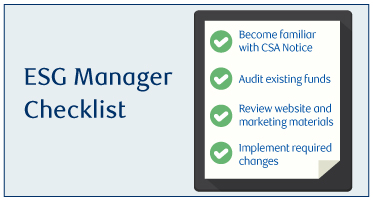In January 2022, the Canadian Securities Administrators (CSA) released new guidance regarding Environmental, Social and Governance (ESG) funds in Canada. David Petiteville, Director of Regulatory Solutions at RBC Investor & Treasury Services, and Lynn McGrade, Partner at Borden Ladner Gervais LLP, discuss the impetus for the guidance, how fund managers are impacted and potential next steps.
Explosive growth in ESG-related investments prompts new guidance from regulators
The CSA Notice1 establishes disclosure requirements for investment funds as they relate to ESG considerations, particularly funds that use ESG strategies or whose investment objectives reference ESG factors. The Notice, which applies to regulatory documents and sales communications, provides guidance about complying with existing requirements and recommends best practices for ESG disclosure.
The CSA released the Notice in response to significant growth in the value and number of ESG funds in Canada, and investor desire for “clear, consistent and comparable” fund disclosure:
- In 2022, the Investment Funds Institute of Canada reported a “dramatic increase” in ESG investing over the prior two years.2 The CSA Notice comments that, by April 2021, the value of “sustainable funds” in Canada grew by 160% since the start of 2020, and the number of sustainable funds increased to 156 compared to 105 at the same time the prior year
- Coincident with this significant growth in ESG funds, Canadian investors are increasingly looking for reporting on how funds have performed on their ESG objectives to complement investment performance reporting
“The goal of the Notice is to prevent greenwashing,” comments McGrade, “where there could be an inadvertent misconception or confusion for investors about what they're actually buying.” As a result, the Notice requires funds to describe their ESG strategies in plain language, using “clear and comprehensive” explanations of ESG terms.
Review required: Are you impacted?
The Notice is based on existing securities regulatory requirements and does not create any new legal requirements or modify existing ones. It came into effect upon release and applies to all funds, including those that have ESG terminology in their name, objectives or strategy.
Managers should consider reviewing the Notice “as it applies whether or not you have existing ESG funds, plan to launch new ESG funds or have funds without ESG components,” comments Petiteville.
The Notice also introduces the following new terminology:
- ESG funds reference an ESG factor as part of the investment objectives
- ESG-strategy funds use ESG strategies but may not have ESG-related terminology in their name or objectives
- ESG-related funds is a catch-all category that includes both ESG funds and ESG-strategy funds
Practical steps to position your funds in the ESG context
The guidance covers multiple areas of ESG-related disclosure, including investment objectives and fund names, fund types, investment strategies disclosure, proxy voting and shareholder engagement policies and procedures, risk disclosure, suitability, continuous disclosure, and sales communications. Due to the range of areas included in the Notice, managers should ensure they review how the guidance may impact their funds.

McGrade walks fund managers through a three-step process for responding to the guidance contained in the Notice:
- The first practical step is for managers to ensure they're familiar with the guidance by reviewing the Notice in detail
- Next, fund managers should audit their existing products to see where and how they fall into the new guidance: Do they have ESG funds, ESG-strategy funds or ESG-related funds
- Finally, once managers have identified the categories their funds fall into, they should perform a “gap analysis” by reviewing their website and marketing materials to check whether updates are required to comply with the Notice
Once this process is complete, managers should step back and confirm “where you've landed,” comments McGrade. “Given the guidance, are your existing and new funds in the categories you'd like them to be?” She adds: “If not, consider what changes are needed to position your funds to meet your goals.”
What's next? What to expect as global ESG investing trends accelerate
As ESG investing becomes more mainstream, regulators are expected to increasingly align Canadian standards to global requirements, comments Petiteville. Still, the lack of guidance from the CSA on standard terminology can present challenges for Canadian fund managers who are operating in a global context. As a result, he notes that common definitions and taxonomy may be on the agenda for future development.
Petiteville says managers should expect to see increased harmonization of the measurement of ESG-related performance, potentially including a regulation to establish rating, ranking and scoring measurement standards. He notes that more enforcement—whether from the CSA or provincial securities regulators—may also be on the horizon.

